This article is part three of a multipart series. Click here to read Part One, Part Two, and Part Four.
Readers, are you ready for our next adventure? After traveling around the western region of the state, let’s tour some of the post office murals of North Texas.
We’ll start out west in Seymour, which calls itself “the crossroads of North Texas” due to its central location at the junction of five major highways. In the town’s old post office building is the 1942 mural Comanches by our friend from El Paso, Tom Lea. It’s painted in that classic Tom Lea style with which we’ve become acquainted (see his murals we visited in Odessa and El Paso). Lea has centered the composition around three mounted warriors galloping towards their next fight. The word Comanche derives from the Ute Indian word that means “enemy” or literally, “anyone who wants to fight me all the time.” In their native language, the Comanche take a different view, calling themselves Nʉmʉnʉʉ (nuh-muh-nuh), which means “the people.”
For those who know anything about Texas history, you’re probably familiar with the reputation of the Comanche people as the “lords of the plains” and as powerfully skilled with horses. Seymour is located in the region that, in the 18th and 19th centuries, was often referred to as Comanchería, or about 250,000 square miles of northwestern Texas (and adjacent states) that the Comanches dominated. Although the U.S. government eventually forced the Comanche out of Texas and into southwestern Oklahoma, where the Comanche Nation is today, the Comanches played an integral role in determining how and when the American West opened to settler colonialism. Think about it: Why did the French stop moving west from Louisiana? The Comanches. Why did the Spanish stop moving north from Mexico? The Comanches. In fact, it’s why the Mexican government allowed Stephen F. Austin and his group to settle in Texas in the first place — to act as a barrier between the Mexicans and the Comanches.
Having written novels about the southwest, Lea was no stranger to the reputation of the Comanches. Lea explained his choice of subject matter: “The town [Seymour] is in the heart of the former marches of the wild Comanches; and any old timer’s eye will light up with a Comanche story at the mere mention of the name…Among all the wild and daring and skillful riders North America has seen, authorities place the Comanches at the top of the list. So it is natural to paint them [on] horseback — wild and free on the boundless plains in the early morning light.” The artist recognized the contributions of the Indigenous spirit to the conscience and character of the country, and celebrated the Comanches in his Seymour post office mural.
Next we travel east to Decatur. Whereas many of the post office murals I’ve visited so far are heavily populated with people and action, Ray Strong’s 1939 Texas Plains is all about the land, with a tiny mounted cowboy barely visible in the central foreground. His post office mural portrays the fundamental characteristics of the region’s environment. Strong preferred to paint plein-air, urging other artists to, “Look at the land! Get out, live in it! Sleep in it! Paint it!” In his Decatur mural, Strong captures the light, the color, and the geography of the area.
Not a Texan by any means, Strong grew up in Oregon, studied at the California School of Fine Arts in San Francisco (which became the the San Francisco Art Institute), and then at the Art Students League in NYC. Later in the 1930s he helped organize the Art Students League of San Francisco, where he taught with Maynard Dixon, who later became one of the premier artists of the American West. Strong is known for western landscapes, particularly of California, but in the case of the Decatur post office mural, he depicts the landscape of the Texas plains. Strong viewed the natural world as the essential ingredient for making art; his work responded to the world around him. Sometimes his landscape paintings were a means through which to highlight conservation and environmental issues.
In it’s seemingly endless, rolling landscape, topped with perfectly puffy clouds, Strong’s mural captures the vastness of the open plains of North Texas. Strong was intentional in his subject and composition. “From contact with the western country and small town folk I know they prefer a decoration with a living quality rather than too formal a decorative treatment of the space. The herd of beef will suggest a major industry of Texas, but my immediate concern about the design was to open up the small Post office lobby and give the person viewing it a sense of great space, sunlight and air.” Today the Decatur post office is a visitor center, which means rather than having 24/7 access, like a functioning post office, you have to catch the mural during business hours — but it’s worth the effort.
Traveling out west a bit on I-20 we stumble across the tiny, quiet town of Ranger. Just off the main strip of downtown is the old post office building with Emil Bristtram’s 1939 mural, The Crossroads Town.
You might not know it by looking at the Ranger mural, but Bisttram’s style ranged from the conventional representational classicism seen here to cosmic abstractions and nonobjective art. The Hungarian-born New Mexico artist had studied Diego Rivera’s fresco technique while visiting Mexico on a Guggenheim grant in 1931, and later cofounded the Taos School of Art. But today, Bisttram is considered one of the best-known members of the Transcendental Painting Group of New Mexico, which was devoted to non-objective painting with the intent to enhance one’s spiritual experience, exemplified in paintings with titles like The Oversoul, or Upward.
Bisttram tried his hand at enhancing the experience of the Ranger by depicting a peaceful scene of the townscape, while in reality the artist found Ranger to be a virtual ghost town. He used his artistic license to imagine the early days as a clean, prosperous place. Visiting Ranger today, it’s clear this small town used to have some life, likely from the boom of oil found nearby in 1918. Obviously this industry went bust since then, as the streets were nearly empty as I drove around town.
A mere ten miles west on I-20 is the more bustling town of Eastland. Just beyond the adorable downtown square is the post office with Suzanne Scheuer’s 1938 mural, Indian Buffalo Hunt. Unlike many other post office murals, it doesn’t expand across the entire wall space above the postmaster’s door, which for me gave it the aura of a history painting rather than embedded decoration. The artist had respect and admiration for the American Indians, and paid tribute to Plains Indian sportsmanship in her Eastland mural. “I am interested in the American Indian and feel sympathetic towards that race of people which was so speedily eradicated by our present civilization. I believe that a reminder, even though it be in the form of a picture, to any one of us of the life in this country that preceded ours can do no harm, especially since that life, in its simplicity and harmony with nature, can be a lesson to us in many ways.”
Scheuer was a California-based artist, studying at the California School of Fine Arts and the California School of Arts and Crafts. For her, art was intended to help us connect with and recognize the humanity in each other, to “make the world a more human dwelling place,” as James Baldwin would say. Because the Eastland mural feels somewhat subdued and unassuming, I was surprised to read about Scheuer’s strong and direct language as an outspoken critic, particularly for the 1930s, of the ways in which Indigenous people were treated. “I think it is well for us to be reminded at times of these people that have speedily been cleared away from their territory to make room for the ‘superior’ white man.” I have to say I agree with Scheuer, that reminders were and are needed, considering the U.S. government’s practices of ethnocide: erasing Native cultures, forcibly moving American Indians onto reservations, and the establishment of boarding schools with the intent to assimilate Indigenous children into American society.
The subject matter of the Eastland mural is exactly what the title describes — a couple of Indigenous men hunting a scattered herd of bison. The colors are subtle, and the scene, though depicting violence, is rather muted, almost gentle. In the lower right corner is a little Texas horned toad. Legend has it that builders of the 1896 county courthouse placed a lizard, among other artifacts, into the cornerstone. Nearly 3 decades later in 1927, when officials opened the cornerstone after tearing down the building, they pulled out the dusty lizard. It was (supposedly) still alive! The reptile went on to become the town’s mascot, known as Ol’ Rip, and visited President Calvin Coolidge at the White House. Can you imagine?
Let’s move east into the heart of the DFW metroplex with a visit to Arlington. Otis Dozier’s 1941 mural, Gathering Pecans, is an uplifting scene. Family members gather pecans, but it’s more than just an afternoon leisure activity. They’re on their hands and knees collecting buckets of pecans and have several large sacks full. When trying to decide what to paint (oscillating between the town’s cotton, pecan, and dairy industries), Dozier learned that during the 1930s the North Texas Agricultural College (now University of Texas at Arlington, though it was part of the Texas A&M University System at the time), offered a federally supported program for pecan propagation and orchard planning. Similar to how the federal government was supporting public projects like the post office murals, federal assistance for the pecan industry and agricultural economy benefited Arlington and its residents, like the family depicted in Dozier’s mural.
A member of the Dallas Nine, Dozier was a Dallas-based artist, where he had studied with early Texas greats like Frank Reaugh and Vivian Aunspaugh. Dozier himself would later become an art teacher, both in Colorado Springs and Dallas. The Arlington mural exhibits a muted palette that viewers of Dozier’s work will see transform into brilliant hues later in his career. Likewise, his naturalistic figures and forms in this mural will morph into a more semi abstract style in later years.
A word to the wise traveler: this mural has moved since I first viewed it. The occupants of the Arlington post office building have changed over the years — most recently it was a branch of the Worthington National Bank. The Amon Carter Museum of American Art acquired the mural in 2017, removing it from the building and moving it to the museum, where it could undergo restoration. Last I checked, it hangs beautifully on display across from the museum store.
We’ll end our North Texas travels in Fort Worth with Frank Mechau’s 1940 murals. For a city that embraces its slogan, “Where the West Begins,” the subject matter for the Fort Worth murals is fitting: folk heroes of the “wild west.” One mural depicts a couple of Texas Rangers among cowboys in a horse corral. With rifles in hand, they’re prepared for a potentially violent confrontation. The other mural shows the beginning of that confrontation with the legendary outlaw Sam Bass (random fact: the confrontation depicted, which ended in Bass’s death, took place in Round Rock, located over 170 miles south of Fort Worth). I suppose the subject is also fitting for a courtroom, where the law reinforces social order and justice. The Texas Rangers have long been seen as keepers of justice, but the agency’s history is much more complicated.
Recent scholarship has unveiled the dark side of the Rangers. While seen by many as defenders of the innocent, they also slaughtered many innocents, particularly among the Mexican and Mexican American population along the Texas-Mexico border, where police brutality at the hands of the Rangers was rampant, establishing their reputation as the Los Diablo Tejanos, the Texas devils.
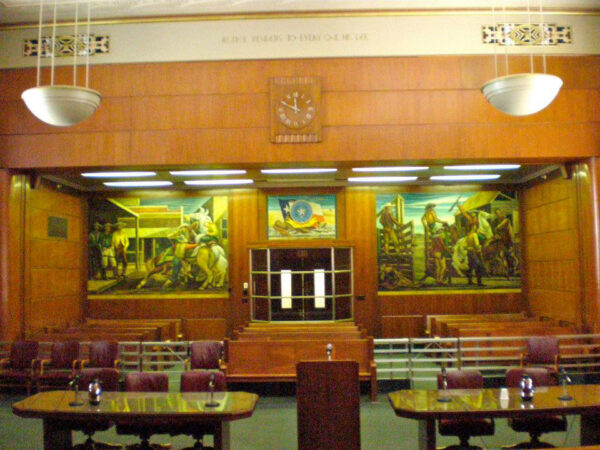
Fort Worth, TX. Frank Mechau, “Two Texas Rangers,” “The Taking of Sam Bass,” and “Flags Over Texas,” 1940. Image: Leslie Thompson.
Frank Mechau (pronounced may-show) was a Colorado-based artist and avid painter of the American West, painting its landscapes, rodeos, oilfields, and wild horses. Having studied in both the U.S. and Europe, Mechau’s artistic influences ranged from Picasso’s cubism to the surrealism of Giorgio de Chirico to ancient Chinese painters. He is a master of line. Look at the sinuous curves of the horses’ tails in the Sam Bass composition.
Mechau is also the master of the public mural. He was awarded 11 commissions during the WPA art projects, the Fort Worth panels being the last of his New Deal murals. Because the Fort Worth murals are not only located in a federal court of appeals, but in an actual courtroom, one must get permission in advance from the presiding judge. Out of all the murals I’ve visited, it required the most effort to view (security nearly confiscated my camera). And I live here!
I hope you enjoyed this journey around North Texas. I’ll meet you down south next time, when we explore Central Texas via some of its post office murals.


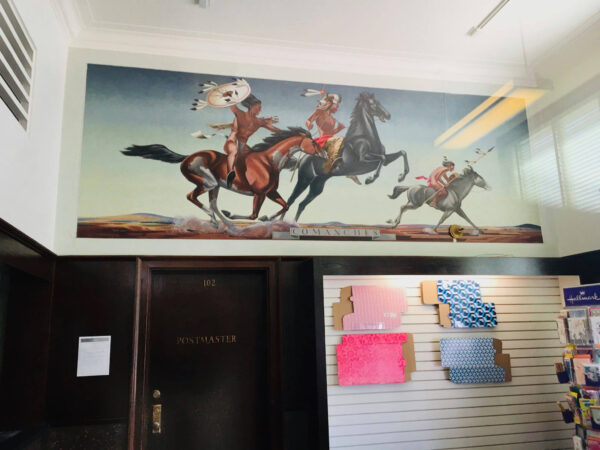
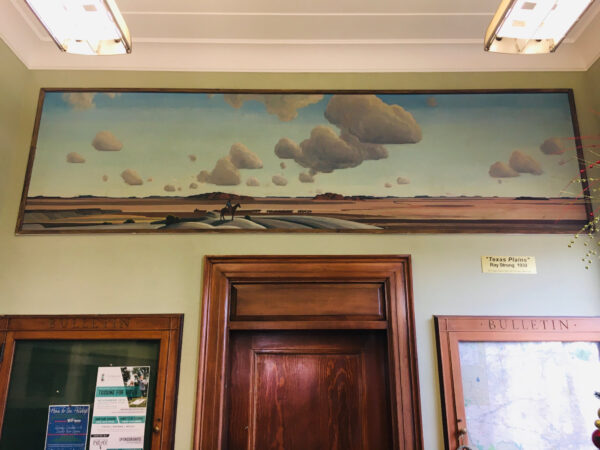
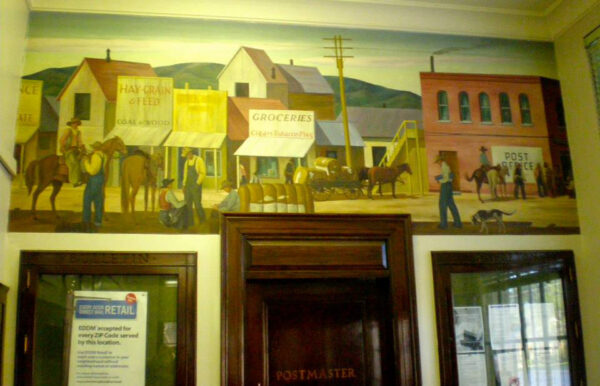
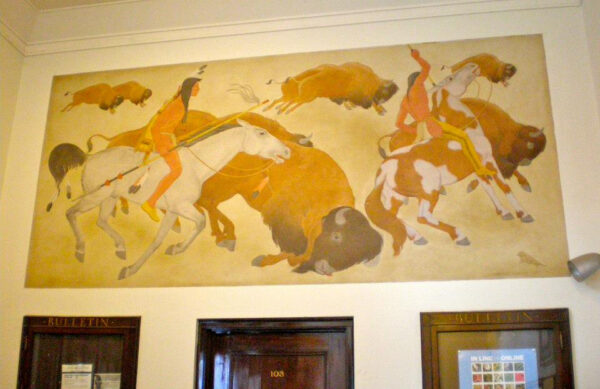
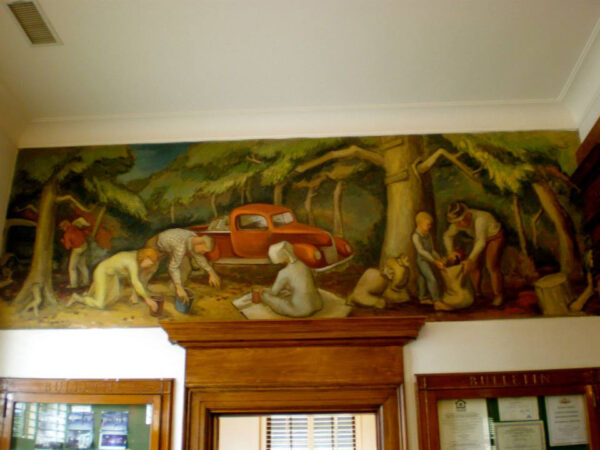
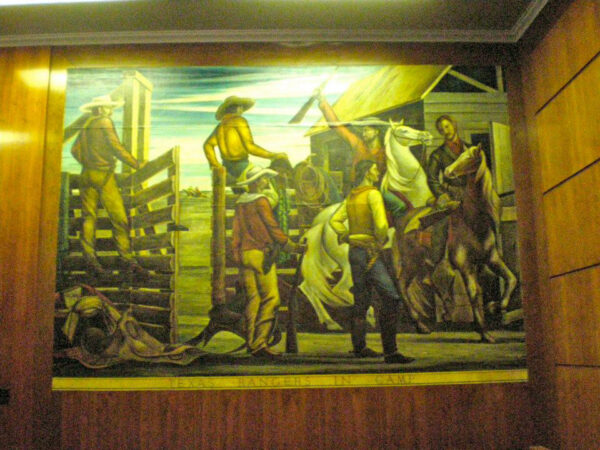
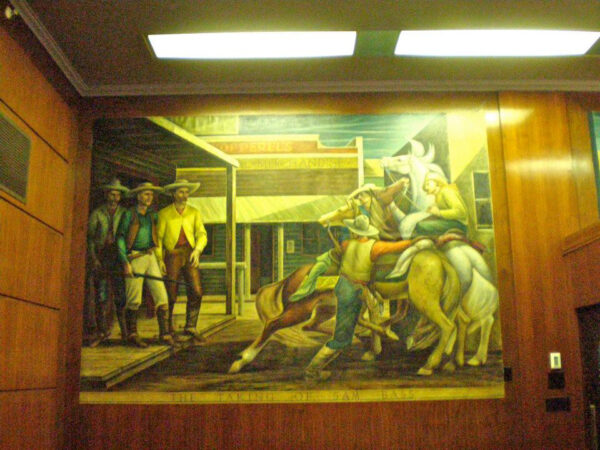

1 comment
On the topic of WPA-era murals in Texas, I recently saw the wild ones in the Hall of State at Fair Park in Dallas (where the Cotton Bowl and Texas State Fair are held). Painted by Eugene Savage in 1936, there are a couple of truly nutty ones in the East Room of the Hall of State: twin homages to local industry, with logging on one end of the room and oil on the other. In the latter, a big central plume of dark brown pollution rises up with hands coming out of it shining God lightbeams onto the industrial landscape. It’s really something.
http://travelphotobase.com/v/USTXD/TXDFP215.HTM
http://www.watermelon-kid.com/places/FairPark/images/etex-mural2.jpg (another view)
http://www.watermelon-kid.com/places/FairPark/images/etex-640.jpg
https://en.wikipedia.org/wiki/Fair_Park
More on Eugene Savage: https://collections.lacma.org/node/166762